Keywords
|
| Exponential smoothing, Forecasting, Holt Winter’s Model, Solar irradiance |
INTRODUCTION
|
| The supply and demand of energy decides the course of global development in all the spheres of human activity. Adequate supplies of clean energy are closely linked with global stability, economic prosperity and quality of life. To meet the ever increasing demands of the world at present and in the subsequent future conventional methods of energy like fossil fuel is not adequate. To meet the increasing requirement of energy we need to exploit more and more renewable energy resources like solar energy, which is gaining more importance each day with the global awareness of clean energy [1]. |
| One of the main challenges in this regard is the integration of renewable energy sources to the existing energy supply systems. This not only demands substantial efforts in further development of advanced technologies but also makes the availability of precise information on the fluctuating wind and solar resources an indispensable necessity. Any efficient implementation of wind and solar energy conversion processes has to account for this behaviour in respective operating strategies. A key issue hereby is the forecasting of renewable energy fluxes, frequently for time scales from the sub-hourly range up to two days depending on the given application [5]. |
| The major drawback of solar energy lies in its discontinuous generation: PV power drops as the solar irradiance drops. Any major decrease in the grid's PV power delivery due to decreased irradiance can pose problems for grid operators who must atone for the shortfall. Therefore, accurate short-term solar irradiance predictions are essential for effectively integrating solar energy sources. The need for solar forecast has become increasingly important as a result of the rising number of solar energy applications. Hence solar forecast is very important for the optimal operation of the grid and is very useful for grid operators in terms of scheduling the conventional generators. |
| Forecasting involves employing current knowledge to develop hypotheses on the future outcome. For an accurate prediction of solar energy utilization, it is imperative to have knowledge of the amount of solar energy utilization, it is imperative to have knowledge of the amount of solar energy that strikes a pre-defined area in the location of study for a specified time period. This allows the researcher to plan the optimal utilization of solar energy. |
| Solar irradiance forecasting is gaining importance due to the increasing solar power generation. Solar irradiance is an important parameter in solar energy application as its generation form photovoltaic (PV) is directly related to this parameter. Solar irradiance varies widely mostly non- linearly due to atmospheric conditions such as cloudy weather, rain, humidity, etc. Therefore the estimation of solar irradiance and thus solar power is very important in regard with its utilization in energy field. A number of models have been proposed for short term forecasting such as moving average, Auto- Regressive Integrated Moving Average (ARIMA), Numerical Weather Prediction (NWP) models, etc. “Exponential smoothing is a technique that can be applied to time series data, either to produce smoothed data for presentation, or to make forecasts. The time series data themselves are a sequence of observations. The observed phenomenon may be an essentially random process, or it may be an orderly, but noisy, process. While in the simple moving average the past observations are weighted equally, exponential smoothing assigns exponentially decreasing weights over time” [2]. The simplest form of exponential smoothing should be used only for data without any systematic trend or seasonal components. |
| In this paper single exponential smoothing model is developed using the available data for solar irradiance and using this model the next day’s solar irradiance is predicted. Various plots of solar irradiance as a function of time is obtained for different values of weighting factor/smoothing factor and from this the optimum value of smoothing factor has been determined. |
| The paper has been structured as follows. Section II describes how data has been analysed. The next section describes the exponential model and shows the various plots obtained. The following section provides a comparative analysis of the exponential model and regression models. Finally, the paper ends with the conclusion. |
ANALYSIS OF DATA
|
| The data used for this paper is collected from Bagalkot Weather station for the months of February through May 2013. The data samples are available for every minute in the given period. Here since the amount of data is huge, the data was normalized by averaging it to ten minutes. For the models proposed in this paper a portion of the available data was used as training set and a portion of it used as test set. |
ANALYSIS OF PARAMETERS
|
| It is the amount of solar energy that strikes a specific area at a specified time. The Earth receives solar radiation whose amount is obtained from its cross section, but as it rotates this energy is scattered across the entire surface area. Hence the average incoming solar radiation, called the solar irradiance, taking into account the angle at which the rays strike is one-fourth the solar constant (approximately 342 W/m²). At any given moment, the amount of solar radiation received at a location on the Earth's surface depends on the state of the atmosphere and the location's latitude [3]. The most important factor which affects the solar radiation received at a particular location of the earth is the atmospheric conditions such as clouds, rain, etc. |
| The Solar Irradiance that hits the surface of the earth is in two forms, beam radiation (Gb) and diffuse radiation (Gd). The beam component comes directly as irradiance from the sun, while the diffuse component reaches the earth indirectly and is scattered or reflected from the atmosphere or cloud cover. Thus the total radiation at any surface can be represented by the equation (1) |
 |
SINGLE EXPONENTIAL SMOOTHING
|
| Single exponential smoothing is an extension of moving average method in which forecasting is done by weighted moving average. In simple moving average forecasts, the mean of all the past observations was used as forecasts. This indicates that equal weights for all past points. However with forecasting, the most recent observations will usually provide the best guide as to the future, so a weighting scheme that has decreasing weights as the observations get older, need to be used [2]. |
| A class of methods that imply exponentially decreasing weights as the observations gets older are called exponentially smoothing procedures. There is a variety of exponentially smoothing methods. They have a common property that recent values are given more weight in forecasting than the older observations. In exponential smoothing there are one or more smoothing parameters to be determined explicitly and these choices determine the weights assigned to the observations. |
| The equation for single exponential smoothing forecasting model is given by equation (2) |
 |
| From the equation (2), it can be seen that the forecast of the future value depends upon the present actual value and the forecast value of the present obtained from the past values. Here it can also be seen that the weightage for the past values of the variable is exponentially decreasing. Hence this method is called the method of exponential smoothing. Here the immediate past value has more bearing on the forecast, when compared to others. |
| The following single exponential smoothing analysis is carried out in Microsoft Excel [6] feature called Exponential Smoothing available under Data Analysis add on. The Figures below show the exponential smoothing curves for three different values of α. |
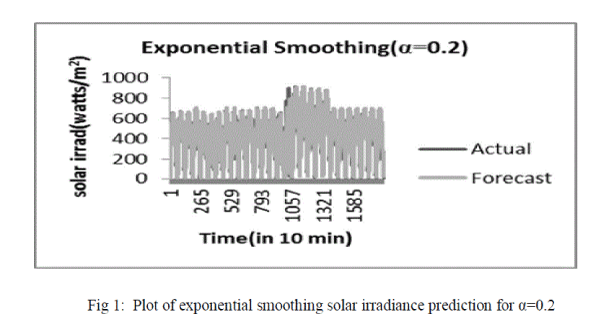 |
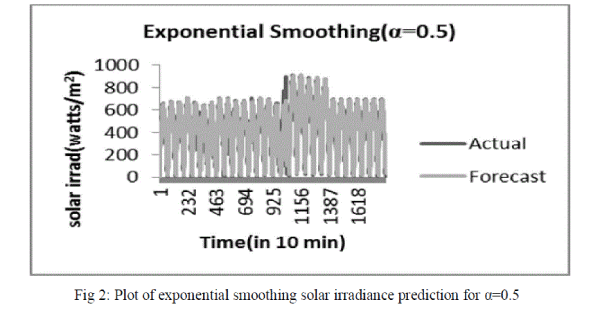 |
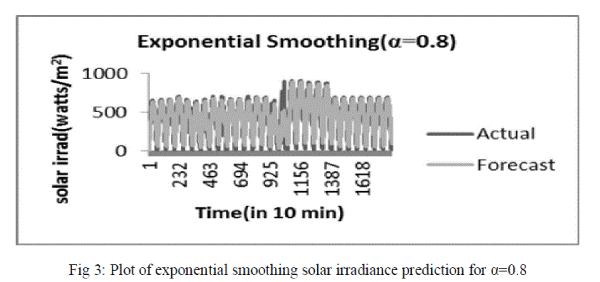 |
| From these plots we can interpret that for smaller values of α; the forecast curve closely follows the actual time series curve. As the value of α increases forecast does not properly predict the smaller values of solar irradiance, though the prediction near the mean is almost acceptable. The main reason for this behaviour is that when the value of α increases, the weights for consideration of the recent values of solar irradiance for the forecast is more and hence the predictions are huge even though the actual values are far less. |
| By determining the mean square and optimizing it to least value the optimal value of α was determined to be 0.6825. Using this value of α next day’s solar irradiance was predicted. The curve showing the next day’s solar irradiance is shown in Fig 4. |
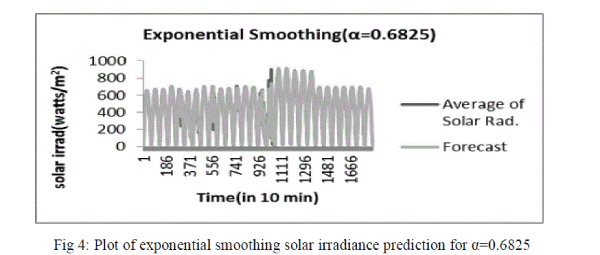 |
HOLT WINTER’S MODEL
|
| Single exponential smoothing method is mostly applicable for simple data with no trend or seasonal component. But when the data has any of these components, the double and triple exponential smoothing is considered for better modelling of the data. This method is also called as the Holt-Winter’s trend and seasonality method (after the names of the inventors) [8]. Seasonality is defined to be the tendency of time series data to exhibit behaviour that repeats itself every ‘L’ periods (where L is the season length in periods). Trend is defined to be the general increasing or decreasing nature of the time series data over a period of time. |
| A. DOUBLE EXPONENTIAL SMOOTHING |
| This method is used when the data available shows a trend pattern. Exponential smoothing with a trend pattern works much like simple smoothing method except that two components must be updated each period - level and trend. The level is a smoothed estimate of the value of the data at the end of each period. The trend is a smoothed estimate of average growth at the end of each period. The formula for simple double exponential smoothing is given by equations (3) and (4). The equation (3) shows the smoothing for the level component – this component is assumed to be devoid of trend and seasonality. And equation (4) gives the smoothing of the trend component |
 |
 |
| The forecast is obtained from both level and trend components as per the equation (5) |
 |
| The following double exponential smoothing analysis is carried out in Microsoft Excel [6], [7] feature called Double Exponential Smoothing available under Num Excel which is an add on in Microsoft Excel. The Figure below show the double exponential smoothing curves for optimal value of α and β. |
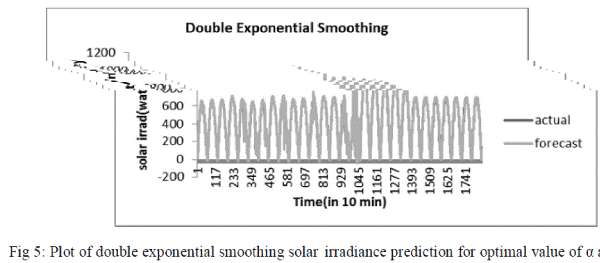 |
| B.TRIPLE EXPONENTIAL SMOOTHING |
| Triple exponential smoothing method is used when the data shows both trend and seasonality components. To tackle seasonality, we have to add a third parameter. We now introduce a third equation to take care of seasonality. There are two main HW models, depending on the type of seasonality – Multiplicative Seasonal Model and Additive Seasonal Model. But in case of solar irradiance, the data only follows additive seasonality. Hence the additive seasonal model is used for the triple exponential smoothing. |
| The formula for simple triple exponential smoothing is given by equations (6), (7) and (8). The equation (6) shows the smoothing for the level component, equation (7) gives the smoothing of the trend component and equation (8) gives the smoothing of the seasonality component. |
 |
 |
 |
| The forecast is obtained from the level, trend and seasonal components as in equation (9) |
 |
| The triple exponential smoothing analysis is carried out in Microsoft Excel [6], [7] feature called Triple Exponential Smoothing available under Num Excel which is an add on in Microsoft Excel. The Figure below show the double exponential smoothing curves for optimal value of α, β and γ. |
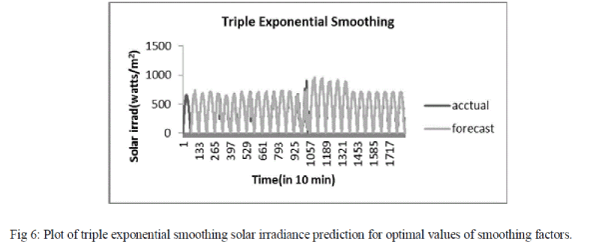 |
COMPARISON OF THE DIFFERENT MODELS FOR A DAY AHEAD FORECASTING OF SOLAR IRRADIANCE
|
| By comparison of plots (4) and (5) it can be inferred that the double exponential smoothing model fits the data better than the single exponential smoothing model. This is because the solar irradiance contains trend component which is not considered in single exponential model. However it can also be seen that the predicted values in double exponential models largely deviate from the actual value of the data. This occurs because the seasonal component of data is not accounted for in the double exponential smoothing model. Hence the triple exponential model is better than both single and double exponential model as it not only considers the trend component but also takes into account the seasonality of the data too. This is clearly seen from the plot (6). |
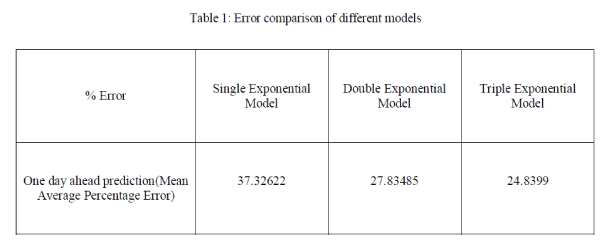 |
CONCLUSION
|
| From the plots obtained it can be concluded that the triple exponential model fits the data better than both double and single exponential model. This is because soar irradiance contains both trend and seasonal components which is considered fully only in triple exponential model. By looking at the error comparison of different models for a day ahead prediction we can conclude that the triple exponential model is better suited for prediction of solar irradiance than the other exponential models. However with more amount of data these models shows more errors, hence other methods like time series models can be tried for better solar irradiance forecast. |
References
|
- Nathan S. Lewis, George Crabtree, etc. “Basic research needs for solar energy utilization”, Report of the basic energy sciences workshop on solar energy utilization, April 18-21 2005, pp. 3-6.
- “Forecasting Methods and Applications”, Sypros Makridakis, Steven C Wheelwright and Rob J Hyndman, 3rd edition, 2013, Wiley Student Edition.
- Warren Tennant, "Applications of ensemble forecasting products for medium-range forecasts", Research Group for Seasonal Climate Studies-South African Weather Bureau.
- Lei Zhang, Yaoyu Li, “Optimal energy management of wind battery hybrid power system with two scale dynamic programming”, IEEE Transactions on Sustainable Energy, February 2013.
- M. Ahlstrom and A. Kankiewicz, "Solar Power Forecasting" presented at Solar Power International conference Los Angeles, California, 2010.
- “Statistics for Mangers Using Microsoft Excel”, David M. Levine, David F. Stephan, Timothy C. Krehbiel, Mark L. Berenson, 6th edition, 2011, Pearson Prentice Hall.
- Malcolm R. McCaskill, “Prediction of solar radiation from rain day information using regionally stable coefficients”, Agricultural and Forest Meteorology, Volume 51, Issues 3–4, July 1990.
- Gordon Reikard, “Predicting solar radiation at high resolutions: A comparison of time series forecasts”, Solar Energy, Volume 83, Issue 3, March 2009.
- Cheng Hang, Cao Wu-shun, Ge Peng-jiang, “Forecasting Research of Long-term Solar Irradiance and Output Power for Photovoltaic generation system”, Fourth International Conference on Computational and Information Sciences, 2012.
- Md Rahat Hossain, Amanullah Maung Than Oo, A. B. M. Shawkat Ali, “Hybrid Prediction Method for Solar Power Using Different Computational Intelligence Algorithms”, Smart Grid and Renewable Energy, 2013.
|